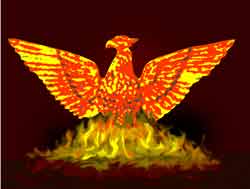
Dimdima
Online Children's Magazine from India

Dimdima
Online Children's Magazine from India

The phoenix is first mentioned in the works of ancient Greek writers. According to these accounts, the phoenix was a bird with feathers of red and gold and a melodious voice. It would arrive in the land of Phoenicia every 500 years, from the East.
The bird would make a nest of wild cinnamon in a palm tree. When it felt death approaching it would break out into a sad song and the creatures around would be so enthralled by the beauty of its voice that some of them would be overcome by emotion and drop dead. The phoenix would then set fire to the nest and burn along with it.
Three days later a new bird would emerge from the ashes.
This bird would make an egg-shaped mass out of the ashes of the previous bird using a sweet-smelling resin called myrrh and aromatic leaves for the purpose and fly with it to the Temple of the Sun at Heliopolis in Egypt.
There, it would place the egg on the altar, bow to the Sun and fly away, only to return in another 500 years.
Some scholars are of the opinion that this fanciful tale was woven around a real bird - New Guinea's bird-of-paradise. This bird with its resplendent golden plumage fits the description of the phoenix. In 1957, Australian anthropologists found that New Guinea aboriginals had been supplying bird-of-paradise feathers to foreign traders for centuries. To make the feathers unpalatable to moths and other insects while they were being transported across sea and land to distant markets as far away as Arabia, the feathers were wrapped in myrrh and banana leaves that had been treated in fire to make them more flexible. The final result was a package with an egg-like shape.
The myth of the phoenix may have been created by an imaginative writer who saw the golden feathers being taken out of their scorched egg-like containers, in the land of Phoenicia (now southern Syria).
Last updated on :9/2/2003
EXPLORE MORE...
COMMENT ON THIS ARTICLE
Wants to share something related to this article? Please use the form below.
Dimdima is the Sanskrit word for ‘drumbeat’. In olden days, victory in battle was heralded by the beat of drums or any important news to be conveyed to the people used to be accompanied with drumbeats.
Bharatiya Vidya Bhavan
K. M Munshi Marg,
Chowpatty, Mumbai - 400 007
email : editor@dimdima.com
Bharatiya Vidya Bhavan
505, Sane Guruji Marg,
Tardeo, Mumbai - 400 034
email : promo@dimdima.com
Dimdima.com, the Children's Website of Bharatiya Vidya Bhavan launched in 2000 and came out with a Printed version of Dimdima Magazine in 2004. At present the Printed Version have more than 35,000 subscribers from India and Abroad.